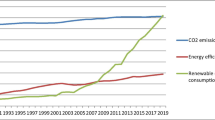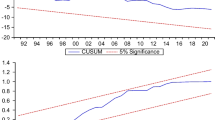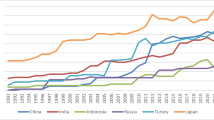Abstract
Environmental pollution has intensified significantly in the last few decades. Policymakers have considered this issue due to its direct influence on human lives throughout the globe. This study explores the asymmetric determinants of consumption-based and production-based CO2 emissions for China, for time horizon 1990–2019. ARDL and NARDL regression approaches have been adopted for empirical investigation. The ARDL regression method reveals that GDP does not produce any impact on production-based and consumption-based CO2 emissions, while energy use contributes as an increasing determinant of consumption-based and production-based CO2 emissions in the long-run. The NARDL regression method reveals that a positive shock in GDP is beneficial for a decline of consumption-based CO2 emissions, while it does not reduce production-based CO2 emissions in the long-run. However, negative shock in GDP contributes as an increasing determinant of consumption-based CO2 emissions. Results also report that positive shock in energy use behaves as an increasing agent of consumption-based and production-based CO2 emissions in the long-run, while negative shock in energy use produces a decline in production-based CO2 emissions in the long-run. Thus, policymakers should adopt such demand and supply sides’ management policies that contribute to controlling CO2 emissions.

Similar content being viewed by others
Availability of data and material
The datasets/materials used and/or analyzed for the present manuscript are available from the corresponding author on reasonable request.
References
Abbasi KR, Adedoyin FF (2021) Do energy use and economic policy uncertainty affect CO2 emissions in China? Empirical evidence from the dynamic ARDL simulation approach. Environ Sci Pollut Res 28(18):23323–23335
Adebayo TS, Awosusi AA, Kirikkaleli D, Akinsola GD, Mwamba MN (2021) Can CO2 emissions and energy consumption determine the economic performance of South Korea? A time series analysis. Environ Sci Pollut Res 28(29):38969–38984
Aslam B, Hu J, Hafeez M, Ma D, AlGarni TS, Saeed M, ... Hussain S (2021) Applying environmental Kuznets curve framework to assess the nexus of industry, globalization, and CO2 emission. Environ Technol Innov 21:101377
Bahmani-Oskooee M, Akhtar P, Ullah S, Majeed MT (2020a) Exchange rate risk and uncertainty and trade flows: Asymmetric evidence from Asia. J Risk Finan Manag 13(6):128
Bahmani-Oskooee M, Usman A, Ullah S (2020b) Asymmetric J-curve in the commodity trade between Pakistan and United States: evidence from 41 industries. Eur Econ Rev 10(2):163–188
Barrett J, Peters G, Wiedmann T, Scott K, Lenzen M, Roelich K, Le Quéré C (2013) Consumption-based GHG emission accounting: a UK case study. Clim Pol 13(4):451–470
Camara M (2020) Determinants of production-based and consumption-based CO2 emissions: a comparative analysis. Int J Environ Pollut 67(1):22–47
Baloch MA, Danish, Qiu Y (2021) Does energy innovation play a role in achieving sustainable development goals in BRICS countries? Environ Technol1-10
Destek MA, Aslan A (2017) Renewable and non-renewable energy consumption and economic growth in emerging economies: evidence from bootstrap panel causality. Renew Energy 111:757–763
Feng K, Hubacek K, Sun L, Liu Z (2014) Consumption-based CO2 accounting of China’s megacities: the case of Beijing, Tianjin, Shanghai and Chongqing. Ecol Indic 47:26–31
Jafri MAH, Abbas S, Abbas SMY, Ullah S (2022) Caring for the environment: measuring the dynamic impact of remittances and FDI on CO2 emissions in China. Environ Sci Pollut Res 29(6):9164–9172
Jian L, Sohail MT, Ullah S, Majeed MT (2021) Examining the role of non-economic factors in energy consumption and CO2 emissions in China: policy options for the green economy. Environ Sci Pollut Res 28(47):67667–67676
Ki-Moon B (2013) The millennium development goals report 2013. Unit Nat Pubns 365:366
Lei W, Ozturk I, Muhammad H, Ullah S (2021) On the asymmetric effects of financial deepening on renewable and non-renewable energy consumption: Insights from China. Econ Res-Ekonomska Istraživanja 1–18
Lei W, Xie Y, Hafeez M, Ullah S (2022) Assessing the dynamic linkage between energy efficiency, renewable energy consumption, and CO2 emissions in China. Environ Sci Pollut Res 29(13):19540–19552
Li X, Ullah S (2022) Caring for the environment: how CO2 emissions respond to human capital in BRICS economies? Environ Sci Pollut Res 29(12):18036–18046
Li ZZ, Li RYM, Malik MY, Murshed M, Khan Z, Umar M (2021a) Determinants of carbon emission in China: how good is green investment? Sustain Prod Consump 27:392–401
Li Z, Wang J, Che S (2021b) Synergistic effect of carbon trading scheme on carbon dioxide and atmospheric pollutants. Sustainability (Basel, Switzerland) 13(10):5403. https://doi.org/10.3390/su13105403
Li J, Jiang T, Ullah S, Majeed MT (2022a) The dynamic linkage between financial inflow and environmental quality: evidence from China and policy options. Environ Sci Pollut Res 29(1):1051–1059
Li X, Ozturk I, Majeed MT, Hafeez M, Ullah S (2022b) Considering the asymmetric effect of financial deepening on environmental quality in BRICS economies: policy options for the green economy. J Clean Prod 331:129909
Liu X, Bae J (2018) Urbanization and industrialization impact of CO2 emissions in China. J Clean Prod 172:178–186
Liu J, Murshed M, Chen F, Shahbaz M, Kirikkaleli D, Khan Z (2021) An empirical analysis of the household consumption-induced carbon emissions in China. Sustain Prod Consump 26:943–957
Ma Q, Murshed M, Khan Z (2021) The nexuses between energy investments, technological innovations, emission taxes, and carbon emissions in China. Energy Policy 155:112345
Munksgaard J, Wier M, Lenzen M, Dey C (2005) Using input-output analysis to measure the environmental pressure of consumption at different spatial levels. J Ind Ecol 9(1-2):169–185
Pesaran MH, Shin Y, Smith RP (1999) Pooled mean group estimation of dynamic heterogeneous panels. J Amer Stat Assoc 94(446):621–634
Pesaran MH, Shin Y, Smith RJ (2001) Bounds testing approaches to the analysis of level relationships. J Appl Econ 16(3):289–326
Quan Q, Liang W, Yan D, Lei J (2022) Influences of joint action of natural and social factors on atmospheric process of hydrological cycle in Inner Mongolia, China. Urban Clim 41:101043. https://doi.org/10.1016/j.uclim.2021.101043
Rehman A, Ulucak R, Murshed M, Ma H, Işık C (2021) Carbonization and atmospheric pollution in China: the asymmetric impacts of forests, livestock production, and economic progress on CO2 emissions. J Environ Manag 294:113059
Shahbaz M, Khan S, Ali A, Bhattacharya M (2017) The impact of globalization on CO2 emissions in China. Sing Econ Rev 62(04):929–957
Shin Y, Yu B, Greenwood-Nimmo M (2014) Modelling asymmetric cointegration and dynamic multipliers in a nonlinear ARDL framework. In Festschrift in honor of Peter Schmidt. Springer, New York, pp 281–314
Ullah S, Chishti MZ, Majeed MT (2020) The asymmetric effects of oil price changes on environmental pollution: evidence from the top ten carbon emitters. Environ Sci Pollut Res 27:29623–29635
Ullah S, Ozturk I, Majeed MT, Ahmad W (2021) Do technological innovations have symmetric or asymmetric effects on environmental quality? Evidence from Pakistan. J Clean Prod 316:128239
Usman A, Ozturk I, Ullah S, Hassan A (2021) Does ICT have symmetric or asymmetric effects on CO2 emissions? Evidence from selected Asian economies. Technol Soc 67:101692
Wegener L (2020) Can the Paris agreement help climate change litigation and vice versa? Transnatl Environ Law 9(1):17–36
World Bank (2020) World Development Indicators. June 2020. The World Bank
Wu W, Ma X, Zhang Y, Li W, Wang Y (2020) A novel conformable fractional non-homogeneous grey model for forecasting carbon dioxide emissions of BRICS countries. Sci Total Environ 707:135447
Xia F, Zhang X, Cai T, Wu S, Zhao D (2020) Identification of key industries of industrial sector with energy-related CO2 emissions and analysis of their potential for energy conservation and emission reduction in Xinjiang, China. Sci Total Environ 708:134587
Yin Y, Xiong X, Ullah S, Sohail S (2021) Examining the asymmetric socioeconomic determinants of CO2 emissions in China: challenges and policy implications. Environ Sci Pollut Res 28(40):57115–57125
Zhang D, Ozturk I, Ullah S (2022) Institutional factors-environmental quality nexus in BRICS: a strategic pillar of governmental performance. Econ Res-Ekonomska Istraživanja:1–13
Zhao J, Jiang Q, Dong X, Dong K (2021) Assessing energy poverty and its effect on CO2 emissions: the case of China. Energy Econ 97:105191
Zhou G, Li H, Ozturk I, & Ullah S (2022). Shocks in agricultural productivity and CO2 emissions: new environmental challenges for China in the green economy. Econ Res-Ekonomska Istraživanja, 1-17.
Author information
Authors and Affiliations
Contributions
The idea was given by Juan Yang and Muhammad Hafeez. Juan Yang, Muhammad Hafeez, Atif Khan Jadoon, and Israt Zhan have done the data acquisitions, analysis, and written the whole draft. Juan Yang and Ruafhon Salahodjev read and approved the final version.
Corresponding author
Ethics declarations
Ethical approval
Not applicable
Consent to participate
I am free to contract any of the people involved in the research to seek further clarification and information.
Consent for publication
Not applicable
Conflict of interest
The authors declare no competing interests.
Additional information
Responsible Editor: Ilhan Ozturk
Publisher’s note
Springer Nature remains neutral with regard to jurisdictional claims in published maps and institutional affiliations.
Rights and permissions
About this article
Cite this article
Hafeez, M., Yang, J., Jadoon, A.K. et al. Exploring the asymmetric determinants of consumption and production-based CO2 emissions in China. Environ Sci Pollut Res 29, 65423–65431 (2022). https://doi.org/10.1007/s11356-022-20448-y
Received:
Accepted:
Published:
Issue Date:
DOI: https://doi.org/10.1007/s11356-022-20448-y




